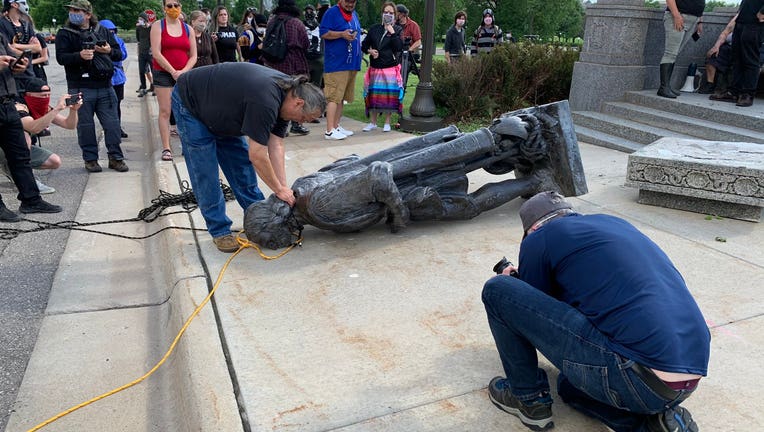Toppled Christopher Columbus statue would cost $154,000 to repair

Christopher Columbus statue is taken down outside the Minnesota State Capitol.
ST. PAUL, Minn. (FOX 9) - Minnesota's Christopher Columbus statue would require $154,000 to repair after protesters yanked it to the ground outside the state Capitol on June 10, according to a damage estimate.
Taxpayers would have to spend $45,000 on the bronze statue itself and another $58,000 on the granite base, including $10,000 on decorative eagle wings that were chipped during the incident.
A state Department of Administration official revealed the estimate during a Thursday afternoon meeting of the Capitol Area Architectural and Planning Board, which has control over statues on the Capitol grounds and must decide what to do next. Two construction and planning firms, Leo A Daly and JE Dunn, did the estimate, said Curt Yoakum, an Administration spokesman.
That amount of damage could qualify for a charge of first-degree criminal damage to property, which calls for up to five years in prison or a fine of no more than $10,000. The Bureau of Criminal Investigation says its investigation is ongoing, and no one has been arrested.
Native American protesters with the group American Indian Movement tied two ropes to the statue's neck and pulled it down with no resistance from the Minnesota State Patrol, despite state officials acknowledging they had at least two hours' notice. The protesters said it was a healing moment because Columbus conquered, enslaved and killed Native people.
The toppled statue is stored in a joint MnDOT-Department of Public Safety building somewhere in the Metro, Capitol facilities management director Chris Guevin said.
The 10-foot statue was a gift from Minnesota's Italians in 1931. It has stood on the south lawn of the Capitol, near the Minnesota Judicial Center, ever since.
"For Indigenous people, having a statue like this in front of the state Capitol, for us, It’s as if there were a statue of Adolf Hitler at the Capitol," said Kate Beane, a CAAP board member.
The CAAP Board did not make any decisions about the statue's fate Thursday, preferring instead to start a lengthy process of developing standards for statue removal.
In an interview, Lt. Gov Peggy Flanagan -- an Ojibwe woman who chairs the CAAP board -- said she wants a yearlong process to gather as much public input as possible.
"I certainly have my own personal feelings. If it were up to me, it would not return to the grounds of the Capitol," Flanagan said.
Many artworks inside the Capitol are also controversial. In 2015, the state moved two controversial paintings from the governor's reception room into a space on the Capitol's lesser-used third floor. The paintings depict the 1851 Treaty of Traverse de Sioux, which white settlers used to take land from Dakota people without payment, and portray Father Louis Hennepin discovering the Falls of St. Anthony in present-day Minneapolis.
Flanagan declined to say whether she thought the AIM protesters who toppled the Columbus statue should be charged.
"It is not my role and responsibility as the lieutenant governor to tell law enforcement who should be charged, but it is my role to lead this process," she said.
Thursday's meeting went on for more than an hour with state administrators explaining how the CAAP board has to sign off before any statues are removed from the Capitol grounds. The Minnesota Historical Society then has authority to decide where to put the removed statue.
The panel's two Republican members, state Sen. Carla Nelson and state Rep. Jerry Hertaus, focused their comments on what happened to the Columbus statue. Nelson pointed out multiple times that it was "illegally" removed, which led state Rep. Raymond Dehn, DFL-Minneapolis, to shake his head.
The fourth lawmaker on the board, state Sen. Sandy Pappas, DFL-St. Paul, lamented that the discussion focused on Columbus instead of developing standards for artwork removal.
"I feel a little bit sidelined by the heavy emphasis on the Columbus statue," she said. "I think people are interested in it. I have questions too, like how much would it cost to remove the entire statue?"
Flanagan said she had heard calls to install a statue of Prince on the Capitol grounds. But Paul Mandell, the CAAP board's executive secretary, said the current policy is to wait 10 years after someone's death.
"Prince would have to wait a little bit longer," he said.
By Friday, the CAAP board will have an email to solicit public feedback at caapb.input@state.mn.us. Members of the public can also call the board's offices at 651-757-1500.

